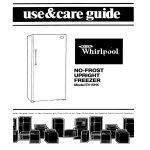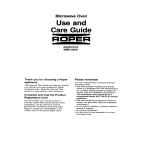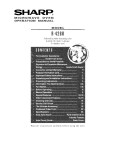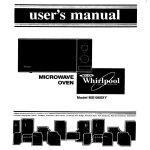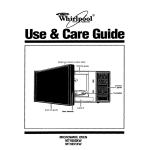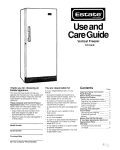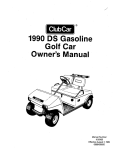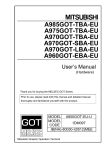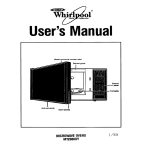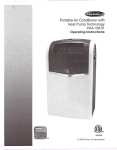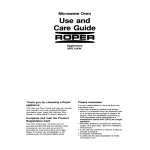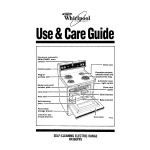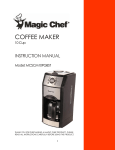Download Whirlpool MCE04XW User's Manual
Transcript
Microwave Oven Use and Care Guide ROPER Appliances MCE04XW Thank you for choosing appliance a Roper This Use and Care Guide will help you operate and maintain your new, qualitybuilt Roper microwave oven. Keep this Use and Care Guide in a safe place for future reference. Complete and mail the Product Registration Card This card enters your warranty into our warranty system that insures efficient claim processing, can be used as a proof of purchase for insurance claims and helps Roper to contact you immediately in the unlikely event of a product-safety recall. Please remember It is your responsibility to be sure that your microwave oven: l Has been properly installed and leveled where it is protected from the elements and on a surface strong enough to support its weight. (See the Installation Instructions.) The microwave oven should be at a temperature above 50°F (10%) for proper operation. l Has been properly connected to electrical supply, and grounded. (See the Installation Instructions.) l Is not used by children or anyone unable to operate it properly. l Is properly maintained. . Is used only for jobs expected of a home microwave oven. c Precautions To Avoid Possible Exposure To Excessive Microwave Energy . . . Do not attempt to operate this oven with the door open since open-door operation can result in harmful exposure to microwave energy. It is important not to defeat or tamper with the safety interlocks. Do not place any object between the oven front face and the door or allow soil or cleaner residue to accumulate on sealing surfaces. Do not operate the oven if it is damaged. It is particularly important that the oven door close properly and that there is no damage to the: (1) Door (bent), (2) Hinges and latches (broken or loosened), (3) Door seals and sealing surfaces. -2- Do not operate the microwave door window is broken. oven if the The microwave oven should be checked for microwave leakage by qualified service personnel after a repair is made. The oven should not be adjusted or repaired by anyone except properly qualified service personnel. Do not operate the microwave oven with the outer cabinet removed. IMPORTANT SAFETY INSTRUCTIONS Microwave ovens have been thoroughly tested for safe and efficient operation. However, as with any appliance, there are special installation and safety precautions which must be followed to ensure safe and satisfactory operation and prevent damage to the unit. l l l l l l l l l l l l l Read all appliance. instructions before using l Read and follow the specific “Precautions To Avoid Possible Exposure To Excessive Microwave Energy” found on page 2. l l Do not let cord hang over edge of table or counter. Electrical shock may result. Follow door surface and interior cleaning instructions on page 14. To reduce the risk of fire in the oven cavity: - This appliance must be grounded. Connect only to properly grounded outlet. See Grounding Instructions found on page 5. Install or locate this appliance only in accordance with the povided Installation Instructions found on page 6. Do not overcook food. Carefully attend appliance if paper, plastic, or other combustible materials are placed inside the oven to facilitate cooking. Paper can char or burn, and some plastics can melt if used when heating foods. - Do not deep fry in oven. - Test dinnerware or cookware before using. See page 17. Some dishes (melamine, Centura@, etc.) absorb microwave energy, becoming too hot to handle and slowing cooking times. Remove wire twist-ties from paper or plastic bags before placing bag in oven. Cooking in metal containers can damage the oven. So can containers with hidden metal (twist-ties, foil lining, staples, metallic glaze or trim). Some products such as whole eggs and sealed containers, for example, closed glass jars-may explode and should not be heated in this oven. Use this appliance only for its intended use as described in this manual. As with any appliance, close supervision is necessary when used by children. Do not operate this appliance if it has a damaged cord or plug, if it is not working properly, or if it has been damaged or dropped. Electrical shock, fire or other hazards may result. - This appliance should be serviced only by qualified service personnel. Call an authorized Roper”” service company for examination, repair or adjustment. l Do not cover or block any opening on the appliance. Fire may result. Do not use outdoors. Damage to the oven or electrical shock may result. l Do not immerse cord or plug in water. Electrical shock may result. If materials inside the oven should ignite, keep oven door closed, turn oven off, and disconnect the power cord, or shut off power at the fuse or circuit breaker panel. Do not heat, store or use flammable materials in or near the oven. Fumes can create a fire hazard or explosion. Read and follow “SAFETY TIONS” on page 13. Keep cord away from heated surfaces. Electrical shock may result. SAVE THESE INSTRUCTIONS -3- PRECAU- CONTENTS INSTALLATION ... .. FEATURES CONTROL . . . PANEL. OPERATING 5 7 7 INSTRUCTIONS 1. SETTING CLOCK ....... 2. HI-POWER COOKING 3. MULTI-POWER 4. TIMER. 8 . ....... COOKING ....... . ....... 5. HOLD WARM ....... 12 ....... 13 SAFETY PRECAUTIONS CLEANING AND CARE. ....... QUESTIONS AND ANSWERS ....... TECHNICAL SPECIFICATIONS ....... MICROWAVE COOKING APPETIZERS . 15 . RECIPES AND TABLES 81 SOUPS ..................... MEAT, FISH 81 POULTRY EGGS AND CHEESE VEGETABLES 14 16 17 19 .................... 20 ....................... 23 ............................. 24 DESSERTS & BREADS APPENDIX ................................ 26 ............................... 28 WARRANTY ..................... 25 -4- INSTALLATION A. EXAMINE OVEN Empty the microwave oven and clean inside it with a soft, damp cloth. Check for damage such as misaligned door, damage around the door or dents inside the oven or on the exterior. If there is any damage, please do not operate the unit until it has been checked by an authorized service technician and any repairs made. B. GROUNDING INSTRUCTIONS Electrical Shock Hazard Improper use of the grounding plug can result in a risk of electrical shock. DO NOT, UNDER ANY CIRCUMSTANCES, REMOVE THE POWER SUPPLY CORD GROUNDING PRONG. For your personal safety, this appliance must be grounded. In the event of an electrical short circuit, grounding reduces the risk of electrical shock by providing an escape wire for the electric current. This appliance is equipped with a polarized 3-prong grounding plug. It must be plugged into a correctly polarized mating 3-prong grounding type wall receptacle, properly installed and grounded in accordance with local codes and ordinances. If a mating wall receptacle is not available or if you are not sure if the wall receptacle is properly grounded and polarized, have it checked by a qualified electrician. It is the personal responsibility and obligation of the customer to have a properly grounded and correctly polarized 3-prong wall receptacle installed by a qualified electrician. Consult a qualified electrician if the grounding instructions are not completely under- stood, or if doubt exists as to whether the appliance is properly grounded. It is not recommended to use an extension cord with your microwave oven, but if you find it necessary to do so temporarily (until a properly grounded and polarized 3-prong receptacle is installed), use only a heavy duty UL listed 3-wire grounding type extension cord containing three 16-gauge (minimum) copper wires. It must not be longer than 10 feet (cords longer than 10 feet may affect the cooking performance of your microwave oven). The plug on the extension cord must fit into a 3-prong grounding type wall receptacle (as shown on this page) and the receptacle end of the extension cord must accept the 3-prong grounding plug of the microwave oven. The marked rating of the extension cord should be equal to or greater than the electrical rating of the appliance. 3-PRONG GROUNDING TYPE WALL RECEPTACLE 3-PRONG GROUNDING PLUG POWER SUPPLY CORD ENSURE PROPER GROUND EXISTS BEFORE USE -5- C. CIRCUITS Observe all governing codes and ordinances. A 120 Volt, 60Hz, AC only, 15 or 20 amp fused electrical supply is required. (Time-delay fuse is recommended.) It is recommended that a separate circuit serving only this appliance be provided. D. VOLTAGE WARNING The voltage used at the wall receptacle must be the same as specificed on the oven serial plate located on the back or on the side of the control panel of the oven. Use of a higher voltage is dangerous and may result in a fire or other type of accidet causing oven damage. Low voltage will cause slow cooking. E. LOCATION OF THE OVEN Your microwave oven can easily be placed in your kitchen, family room or any other room in your home. Place the oven on a flat surface such as a kitchen countertop or a specially-designed microwave oven cart. (The control side of the unit is the heavy side. Use care when handling.) The weight of the oven is approximately 23 Ibs. (10.4 kg). Do not place oven above a gas or electric range. Free air flow around the oven is important. The microwave oven should be placed three inches or more away from the edge of the countertop or cart to avoid accidental tipping of the oven. F. DO NOT BLOCK VENTS All air vents should be kept clear during cooking. If air vents are covered during oven operation, the oven may overheat. In this case a sensitive thermal safety device automatically turns the oven off. The oven will be inoperable until it has cooled sufficiently. Make sure the microwave oven legs are in place to ensure proper air flow. G. TEST THE OVEN To test the oven, plug it into the proper electrical outlet. Put about one cup (250mL) of cold water in a glass container in the oven. Close the door. Make sure it latches. Follow the directions on page 10 to set the oven to cook for 2 minutes. When the time is up, the water should be heated. H. USE OVEN PROPERLY This microwave oven is designed commercial purposes. for use in the household only and must not be used for Do not remove the door, control panel or cabinet at any time. The unit is cquipcld voltage and should not be serviced unless by an authorized service technician. -6- with high Remove your microwave oven and all materials from the shipping carton. Your oven will be the following packed with materials: Oven Front Face Glass Tray Owner’s Manual & Cooking Guide. 1 1 Safety Door Lock System CONTROL PANEL Indicator Light-COOK, HIGH, MED, DEF and TIMER lights indicate which cooking operation is being used. Power- Used in setting cooking power level. Timetime. Used In setting cooking Timer- Used In setting timer. Hold Warm-Used food warm. Clear-Clears 10un lun - Display Window- Used to show: l Cooking time. l Cooking power level. l Time of day. l Cycle selected. - Clock-Used day. in setting time of - Start-Starts the oven. - Door Open Button lOsac non to keep the all entries. I CLEAR u I NOTE: To enter a setting, touch a word or number pad. A beep sounds when a pad on the control panel is touched to indicate a setting has been entered. -7- OPERATING INSTRUCTIONS 1. SETTING CLOCK KEY BOARD STEP 1. Plug the power cord into an electrical outlet. REMARKS DISPLAY WINDOW / 2. Touch CLEAR. 3. Touch CLOCK. , 4. For correct hour touch minute key three times. CLOCK , /I ~ , Min ~ [31 ~ The hour will be set. , ,C Min , ~ 11 ~ t;tfsres,time the minute will , ~ 13::o) ~ 1-I 5. Touch CLOCK. 6. Touch 10 Min and/or 1 Min key for correct minute. 7. Touch CLOCK. (This “locks” in the time and starts the clock running.) ~ CLOCK , I I NOTE: This unit is designed for 120 volts/60 Hz AC circuit only. If oven does not operate properly, remove the plug from wall outlet (120 volt household outlet), then put the plug back in. OPERATION PLUG THE SUMMARY SET THE CORRECT HOUR POWER SET THE CORRECT MINUTE -a- 2. HIGH-POWER COOKING EXAMPLE: If you want to cook food at HIGH-POWER KEY BOARD STEP 1. Touch CLEAR. , for 6 minutes: DISPLAY WINDOW CLEAR , 2. Touch HIGH. REMARKS j ~~~~“,~~~,“~~~a~ settings /I ~~,er~~s”,kng,~~~~~~~~~~w. p-j ~n~~~~~~~t~~~~;~y pTj ‘& 3. Set 6 minutes by touching “1 Min” six times. “6:OO” will show in the display window. , 4. Touch START. 1 Min , START :I Two short and one long beeps will sound when the cooking cycle is over, and the word “End” will appear in the display window. NOTE: 1. To stir food during cookrng, open the door and stir or turn the food over. Close the oven door and touch START. The oven will automatically continue to count down the amount of time left on the timer. 2. While the set cooking time is counting down, you can add the desired additional cooking time by touching the 1 Min key once for each additional minute, up to 9 minutes. 3. The cooking time available on power level HIGH is up to 30 minutes. OPERATION pr-+iL SUMMARY DESIRED TIME -9- COOKING 3. MULTI-POWER COOKING Many foods need slower cooking (at less than HIGH-POWER) in order to give you the best results. ln addition to HIGH-POWER there are two multi-power settings (MEDIUM and DEFROST). The “Microwave Cooking Recipes and Tables” sections of this book tell you which power setting is recommended for the food being cooked. Refer to these sections for detailed reference. EXAMPLE: If you want to cook food at DEFROST for 1 minute 30 seconds: KEY BOARD STEP REMARKS DISPLAY WINDOW 1. Touch CLEAR. 2. To defrost - touch the DEFROST key. 3. Set l-l/z minutes (1 minute 30 seconds) by touching “1 Min” once and “10 Set” three times. “1:30” will show in the display window. 10 set 1 Min II The cooking time will appear in the display window. 4. Touch START. , START , VI ;;i ;r;;;;“,;;;$ show the time count down. When cooking cycle is completed, two short and one long beeps will sound and the word “End” will appear in the display window. I ~ I NOTE: While the set cooking time is counting down, you can add the desired additional cooking time by touching 1 Min key once for each additional minute, up to 9 minutes. Your microwave oven has three power levels (HIGH, MEDIUM and DEFROST). The cooking time available for MEDIUM is up to 30 minutes. The cooking time available for DEFROST is 99 minutes 90 seconds. POWER LEVEL CHART f-gyiq OPERATION SUMMARY POWER START LEVEL -lO- 4. TIMER Your oven also has a timer that can be used for non-cooking functions. When used as a regular timer, the oven is not running. The timer is simply counting down in seconds. See below for detailed instructions. DISPLAY WINDOW KEY BOARD STEP 1. Touch CLEAR. CLEAR ~ I] TIMER ’ ml REMARKS -I 2. Touch TIMER. ,I 3. Touch “10 Min”. 4. Touch START. , START , IEn ;;;;;et~‘;p,e,9;y~,sun”d’d”w” with no cooking or heating in the oven. When time is completed, two short and one long beeps will sound and the word “End” will show in the display window. NOTE: 1. While the set time is counting down, you can add the desired additional time by touching 1 Min key once for each additional minute, up to 9 minutes. To add time over 9 minutes the 10 Min key must be used. For example: to add 12 minutes, touch 10 Min key once then touch 1 Min key twice. 2. The timer can be set for up to 99 minutes 90 seconds. OPERATION SUMMARY TIMER DESIRED TIME -ll- 5. HOLD WARM Your oven has a HOLD WARM feature that keeps the food warm after the cooking is done. If you want to cook food at MEDIUM for 6 minutes. EXAMPLE: KEY BOARD STEP DISPLAY WINDOW REMARKS 1. Touch CLEAR. 2. Touch MEDIUM. , MEDIUM , PI 3. Touch “1 Min” six times. 4. Touch HOLD WARM. 5. Touch START. START ‘I the food warm. The cook control setting changes to loo/o of cook power. NOTE: HOLD WARM will continue for up to 60 minutes if CLEAR has not been touched. At this time, “End” will show in the display window will two short and one tong tones. The HOLD WARM function can be used independently. OPERATION CLEAR SUMMARY DESIRED CYCLE HOLD WARM COOKING HOLD WARM START 1 -12- SAFETY PRECAUTIONS I. Do not attempt to tamper with, or make any adjustments or repairs to door, control panel, safety interlock switches or any other part of the oven. Repairs should be done by qualified service personnel only. 2: Do not hit or strike the control panel with objects such as silverware, utensils, etc. Breakage may occur. 3. Be careful when taking the cooking utensils out of the oven. Some dishes absorb heat from the cooked food and may be hot. Use hot pads. Microwave energy does not heat containers, but the hot food does. 4. Do not rinse cooking utensils by immediately placing them into water just after cooking. This may cause breakage. Allow the glass tray to cool down before cleaning. 5. Do not use metal utensils for cooking. See “UTENSILS” section on page 17. 6. Starting a microwave oven when it’s empty is not recommeneded. If you experiment, put a container of water in the oven. It is normal for the inside of the oven door to look wavy after the oven has been running for a while. 7. Do not heat unopened food containers in the oven. Pressure build-up can cause the container to burst, resulting in injury. 8. Do not use newspaper or other printed paper in the oven. Fire could result. Do not dry flowers, fruit, herbs, wood, paper, gourds or clothes in the oven. Fire could result. 9. Only use thermometers approved for microwave oven cooking. 10. Be certain the glass tray is in place when you operate the oven. 11. Pierce the skin of potatoes, whole squash, apples or any fruit or vegetable which has a skin covering before cooking. Do not overcook potatoes. Fire could result. At the end of the recommended cooking time they should be slightly firm. Wrap in foil and set aside for 5 minutes, They will finish cooking while standing. 12. Never use your microwave oven to cook eggs in the shell or to cook or reheat a whole egg. Steam build-up may cause them to burst and burn you, and possibly damage the oven. Slice hard boiled eggs before heating. In rare instances, poached eggs have been known to explode. Cover poached eggs and allow a standing time of one minute before cutting into them. 13. Do not pop popcorn, except in a microwave approved popcorn popper or commercial package designed especially for microwave ovens. Never try to pop popcorn in a paper bag. Overcooking may result in smoke and fire. 14. Liquids heated in certain containers (especially cylindrical-shaped containers) may become overheated. The liquid may splash out with a loud noise during or after heating or when adding ingredients (coffee, etc.) resulting in harm to the oven and possible personal injury. For best results stir any liquid several times before heating or reheating. 15. Never lean on the door or allow a child to swing on it when the door is open. Injury could result. 16. DO not do canning of foods in the oven. Closed glass jars may explode resulting in damage to the oven or possible personal injury. 17. Do not use the oven to sterilize objects (baby bottles, etc.). It is difficult to maintain the high temperature required for safe sterilization. 18. DO not deep fry in the oven. Microwavable utensils are not suitable and it is difficult to maintain appropriate deep frying temperatures. 19. DO not use the oven for storage. Do not leave paper products, books or cooking utensils in the oven when not in use. Fire may result if someone accidentally starts the oven, 20. Do not let food or containers touch the top or sides of the oven. 21. If a fire should start in the oven cavity: do not open oven door; turn oven off; unplug the oven or turn off the power at the main power supply. 22. Do not place anything on top of the oven. Damage to the oven may result, 23. Do not try to melt paraffin wax in the oven. You may be burned. -13- CLEANING AND CARE BE SURE THE OVEN IS TURNED OFF BEFORE CLEANING. INTERIOR WALLS AND DOOR Keep the inside of the oven clean. Food spatters or spilled liquids stick to oven walls and between seal and door surface. It is best to wipe up spillovers with warm sudsy water and a soft cloth right away. Crumbs and spillovers will absorb the microwave energy and lenghten cooking time. Use warm sudsy water and a soft cloth or sponge to wipe up crumbs that fall between the door and the frame. It is important to keep this area clean to assure a tight seal. Remove greasy spatters with warm sudsy water and a soft cloth or sponge. Then rinse and dry. Do not use harsh detergent or abrasive cleaners. The glass tray can be washed by hand or in a dishwasher. EXTERIORS Keep the outside of the oven clean. Clean the outside of your oven with soap and water, then rinse with clean water and dry with a soft cloth or paper towel. To prevent damage to the operating parts inside the oven, the water should not be allowed to seep into the ventilation openings. To clean control panel, open the door to prevent oven from accidentally starting, and wipe with a damp cloth, followed immediately by a dry cloth. Touch clear pad after cleaning. If steam accumulates inside or around the outside of the oven door, wipe with a soft cloth. This may occur when the microwave oven is operated under high humidity conditions and in no way indicates malfunctions of the unit. NOTE: When you insert or take out the glass tray, you should tilt it sideways to prevent the oven from being damaged. Wipe up liquid spills before removing. QUESTIONS AND ANSWERS Q. What’s wrong when the oven light will not light? A. H Light bulb is burned out. H Door IS not closed. H START has not been touched. Q. Why is steam coming out of the air exhaust vent? A. Steam is normally produced during cooking operations. The microwave oven has been made to vent this steam out of the bottom vent and the side vent. Q. Does microwave energy pass through the viewing screen in the door? A. No. The metal screen reflects the energy to the oven cavity. The holes, or ports are made to allow light to pass; they do not let microwave energy through. Q. Why does the beep tone sound when a pad on the control panel is touched? A. The tone sounds to indicate that the setting has been entered. Q. Will the microwave oven be damaged if it operates while empty? A. Yes. Never run it empty. Q. Why do eggs sometimes pop? A. When baking, frying, or poaching eggs, the yolk may pop due to steam build up inside the yolk membrane. To prevent this, simply pierce the yolk with a toothpick before cooking. Never microwave eggs in their shells. 0. Why is a standing time recommended after the cooking operation has been completed? A. Standing time is very important. With microwave cooking, the heat is in the food, not in the oven. Many foods build-up enough internal heat to allow the cooking process to continue, even after the food is removed from the oven. The standing time for joints of meat, large vegetables and cakes is to allow the inside to cook completely, without overcooking the outside Q. Why doesn’t my oven always cook as fast as the recipes and tables in this book say it should? A. Check the recipes and tables again to make sure you’ve followed directions exactly and to see what might cause variations in cooking time. Times and heat setting are suggestions, chosen to help prevent over-cooking the most common problem in getting used to a microwave oven. Variations in the size, shape, weight and density of the food could require longer cooking time. Use your own judgment along with the cooking suggestions in this book to test for doneness, just as you would do with conventional cooking. Make sure the power level is at the recommended setting and that you are allowing for more time when cooking more food at one time. Also, the electric supply to your home or wall outlets may be low or lower than normal. Your electric company can tell you if the line voltage is low. Your electrician or service technician can tell you if the outlet voltage is low. Q. Why do sparks and crackling (arcing) occur in the oven? A. There may be several reasons why sparks and crackling within cavity (arcing) happen. H You are using dishes with parts or trim containing metal. n You have left a fork or other metal utensil in the oven. H You are using a large amount of metal foil. n You are using a metal twist-tie. -15- TECHNICAL SPECIFICATIONS Power Input Power Output Microwave Frequency Outer Dimensions Cavity Dimensions: Cavity Volume Net Weight Shipping Weight Power Consumption : 12OV, 60Hz, 8.OA, AC only 3-prong grounded plug. : 500 Watts : 2,450MHz : 16l5/16(W) x813/1&H) x117/g(D) inches : 1O13/16(W)x5%(H) ~1111/1~(0) inches : 0.4 Cu.ft. : 23 Ibs. (Approx.) : 26 Ibs. (Approx.) : 900 Watts Weights and dimensions shown are approximate. Specifications are subject to change without notice. The serial number is found on the back of this unit. This number is unique to this unit and not available to others. You should record requested information here and retain this guide as a permanent record of your purchase. Data of Purchase Dealer Purchased Dealer Address Dealer Phone No. Model No. Serial No. -16- From MCE 04XW MICROWAVECOOKING RECIPES AND TABLES INTRODUCTION UTENSILS Your microwave oven can be one of the most useful appliances in your home. If you follow a few basic instructions, this book will teach you how to make microwave cooking both enjoyable and safe. All of the recipes in this book have been tested and proven to provide many rewarding meals for you and your family. Before you begin trying the recipes, take a few moments to read these pages of instructions and helpful hints. Never use metal or metal-trimmed utensils in your microwave oven. Microwaves cannot penetrate metal. They will bounce off any metal object in the oven -just as they bounce off the metal walls of the oven - and cause “arcing”, a phenomenon that resembles lightning. Many of the containers which you already own are perfectly safe to use. How Your Microwave Oven Works: Quite simply, microwaves are a form of energy, just as sunlight and radio waves. The only difference is in the shape and form of the energy wavelengths. When the magnetron tube in your oven is activated, electricity is converted into high frequency radiating energy in the form of very small (micro) waves. The microwaves are released into the oven compartment through an opening in the top of the appliance, and are distributed evenly by a built-in stirrer. When microwaves penetrate food, individual molecules in the food begin to vibrate, and the heat friction caused by this vibration passes from molecule to molecule, cooking the food. Power and Standing Time: Like any conventional oven, microwave appliances are affected by fluctuations in local energy supplies The location of your house, the weather and the time of day may all affect energy availability and thereby vary the rate at which your microwave oven cooks. This book provides you with minimum and maximum cooking times for each recipe to accommodate this possible variation in energy availability. Standing times, which allow the extra cooking to take place, can vary from one to five minutes for vegetables, or five to ten minutes for a large roast. Experience will help you determine standing times for the various foods you prepare. -17- How to Test for Microwave Use: Here is a simple test to determine whether or not a utensil is compatible with your microwave oven. Measure one cup of water into a glass container, and place it on or near the dish you wish to test. Turn microwave on HIGH for one minute, until water is hot, then test the container in question. If the dish remains cool to the touch, it is safe for the microwave oven. Utensils to Use in a Microwave Oven: Containers made of glass, ceramics, and some forms of paper and plastic, allow microwaves to pass freely through them, making them ideal for microwave use. Boilable pouches and oven cooking bags are usually equally effective in your microwave oven. Many utensils are made especially for use in a microwave oven. These heat-resistant plastics may go directly from freezer to microwave and vice versa without harming either food or container. To avoid problems, always read the instructions on these containers before using them. FOOD CHARACTERISTICS YOUR MICROWAVE Many people believe that once the food goes into the timer is set. This is far from techniques are as important selecting quality ingredients TECHNIQUES COOKING & their job is done microwave and the true. The following to your cooking as from the market. Density: Microwaves penetrate porous foods such as cakes or breads more easily than heavy foods such as roasts or casseroles. Dense foods must be cooked for a longer time, and often at a lower power setting to avoid uneven cooking. Starting Temperatures: The initial temperature of food directly affects the length of time they must cook or heat. As in a conventional oven, frozen food takes longer to cook than does refrigerated food, while food at room temperature cooks most quickly. Moisture Content: Because microwaves are attracted to moisture, cooking time will vary according to water content. Naturally moist foods such as vegetables, fish and poultry will cook quickly and evenly; drier foods such as rice or dried beans require added moisture for microwave cooking. Bones and Fat Content in Meat: The bone and fat distribution affects how evenly meats cook in the microwave oven. Boneless cuts cook more evenly, since bones conduct heat to areas near them. Well-marbled meat cooks more evenly. Large areas of fat attract energy away from the meat, and slow cooking. To prevent uneven cooking, meats with bones or large fatty areas may require frequent turning during microwaving. Shape of Foods: Thin parts of uneven foods cook faster than thick parts. Chicken pieces, fish fillets and other foods which vary in thickness will take longer to cook in the thicker portions To promote even cooking, arrange foods so that thicker portions are to the outside, where they will absorb more energy. Quantity of Foods: Microwave times relate directly to the amount of food being cooked. Smaller quantities of food cook faster than large quantities, When doubling a recipe, increase time by about half and check for doneness. Add any additional time very cautiously. Size of Foods: Small, even-sized pieces of food cook more rapidly than large ones, To insure even cooking, cut all pieces of food into similar sizes and shapes. -18- FOR MICROWAVE Every different food has unique characteristics Here are some ideas and guidelines to help you achieve optimum results from your microwave oven. Elevating: As in conventional cooking, foods such as roasts are elevated so they are not allowed to steam in their own juices. Turning foods is especially important here because it allows for more even cooking. Shielding may also be needed to prevent overcooking in some smaller areas. Turning: Turning food while it cooks allows the microwave energy to penetrate all areas. Large items such as roasts must be turned occasionally to promote even cooking. Smaller foods like pork chops should be turned midway through the cooking time or the dish may be rotated. Stirring: As with other cooking methods, prevent uneven cooking by stirring and rearranging food while it is cooking. Since the food towards the outside of a dish heats first, stir from the outside toward the center to promote even heat distribution. Shielding: Certain foods that attract excess microwave energy, such as wing tips and leg ends of poultry, and the corners of square baking pans, can be shielded to prevent overcooking. Shielding done with small pieces of foil will not hurt your oven as long as they do not touch each other or the sides of the oven. Arranging and Spacing: Individual foods like potatoes and muffins should be arranged in a circle at the outside edge of the glass tray. This will guarantee that all the pieces cook evenly at the same rate. Foods which are uneven in thickness, such as chicken wings, should be arranged with the meatier portions to the outside. Delicate foods like asparagus tips should be placed toward the inside of the dish to receive less microwave energy. If possible, always leave spaces between individual pieces of food. Browning: Many microwave utensils are specially designed to allow browning of some foods. A special coating on the bottom of these dishes absorbs microwave energy to create temperatures high enough to brown food such as hamburgers, fried eggs, and grilled sandwiches Use these utensils according to manufacturer’s instructions. APPETIZERS MICROWAVING l l l l l l & SOUPS APPETIZERS & SOUPS: TIPS & TECHNIQUES Many appetizers can be prepared ahead of time, like meatballs and dips. They will reheat well on serving trays and casseroles in just a minute or two. Some other uses for the microwave oven: Cook refrigerated cheese 30 seconds at MEDIUM for easrer slicing. Soften 8 oz. cream cheese for a spread by removing foil and microwave at medium for 1 minute. Freshen potato chips and pretzels by microwaving at HIGH for 1 minute per cup. Let stand until crisp. What you can’t do: Don’t deep fat fry appetizers. Pull pastry does not microwave well Breaded products can be microwaved, but they do not come out crispy. Use HIGH power for water-based soups and MEDIUM for milk or cream-based soups; soups with uncooked meat or chicken start on HIGH and finish on DEFROST. Microwave soups in a container with twice the volume of the ingredients to prevent boiling over. Generally microwaved soups are covered with either a casserole lid, waxed paper or plastic wrap. APPETIZERS COOKING TABLE Amount Food Power Level Cooking Time Meatballs (1 lb.=40) 20 HIGH 3 to 8 minutes Saucy Appetizers (cocktail franks in sauce) 2 cups HIGH 7 to 8 minutes Cheese DIP 1 cup MEDIUM 6 minutes Sour Cream Dip 1 cup DEFROST 5% minutes Canapes (spread on crackers or toast) 12 MEDIUM I I 2 to 4 minutes I CANNED SOUPS COOKING TABLE soup Amount Power Level Water-based - Condensed l-8 oz. serving 10% oz. can HIGH HIGH Milk or Cream-based - Condensed l-8 oz. serving 10% oz. can 15 oz. can MEDIUM MEDIUM MEDIUM 3 to 5 minutes 7 to 8 minutes 11 to 12 minutes Bean, pea or mushroom - Condensed l-8 oz. serving 10% oz. can MEDIUM MEDIUM 3 to 5 minutes 7 to 8 minutes Undiluted Chunk-style 10% oz. can 19 to 20 oz. can HIGH HIGH 3 to 4 minutes 6 to 7 minutes 1. Mix soup as directed on can or package in a 1% or 2-quart casserole; in a mug or soup bowl. 2. Cover and microwave as directed above. Stir once or twice. 3. Let stand, covered, 3 minutes before serving. -19- Cooking Time 2% to 3% minutes 6 to 8 minutes individual servings can be heated MEAT, FISH & POULTRY DEFROSTING l l l l MEAT, POULTRY, FISH & SHELLFISH: TIPS & TECHNIQUES You can defrost meats and poultry in their original wrapping as long as no metal is present. Remove any metal rings, twist ties, wire or foil. Place meat and poultry in a shallow baking dish to catch juices. Defrost meat using the defrosting table. Separate items like chops, hot dogs, and bacon as soon as possible. Remove thawed portions and continue to defrost remaining pieces. Whole pieces of meat are ready for standing time as soon as a fork can be pushed into the center of the meat using moderate pressure. The center will still be icy. Allow to stand until completely thawed. DEFROSTING I Amount Item BEEF frankfurter ground beef roast, rib (rolled) roast, rump (boneless) roast, sirloln tip steak, sirloin steak, cubed 1 lb. 1 lb. 3-4 tbs. 3-4 Ibs. 4-5 Ibs. 2 Ibs. 1 lb. LAMB roast, leg or shoulder 4-5 Ibs. VEAL chop ground veal steak PORK chop (l/z” thick) cubes ground pork roast, loin (boneless) 1 FISH FILLETS SCALLOPS Standing Time 25-30 minutes 15 minutes 1 lb 1 lb. 1 lb. 9-10 minutes 4-5 minutes 6-8 minutes 10 minutes 10 minutes 10 minutes 1% Ibs. 1% Ibs. 1 lb. 8-13 minutes 8-10 minutes 5-6 minutes 10 10 10 20 I minutes minutes minutes minutes 8-12 minutes 20 minutes 15 minutes 20 minutes 22-28 minutes 25 minutes 12-15 minutes 16-21 minutes 15 minutes 20 minutes 27-37 minutes 25 minutes I T 2-3 Ibs. 4-5 Ibs. 4-5 Ibs. 1 lb. 1.~ ~- pmmtmlib-T~ A LOBSTER TAILS SHRIMP Time 10 minutes 10 minutes 15 minutes 15 minutes 20 minutes 10 minutes 10 minutes %-‘I Ibs. ~-______ TURKEY ~-____ parts breast (bone-in) ~______ DUCKLING, WHOLE T Defrosting 5-6 minutes 6-8 minutes 13-18 minutes 18-23 minutes 25-30 minutes 11-13 minutes 7-8 minutes CHICKEN whole parts breasts (bone-in) CORNISH HENS WH9LE TABLE i : 5-6 minutes ~Ap~~~ 6-8 minutes Tm. -2o- 5 to 10 minutes - 5 to 10 minutes 8-9 minutes 5 to 10 minutes 5-6 minutes 5 to 10 minutes CONVENIENCE Convenience Meat Amount Cooking Power Level Time Standing Time bacon slices 2 3 4 8 HIGH 2-2’12 minutes 2,/z-4 minutes 5-6 minutes 7-10 minutes 1 1 1 1 Canadian slices 2 4 8 HIGH 2-3 minutes 3-5 minutes 5-6% minutes 1 minute 1 minute 1 minute frankfurters 2 4 HIGH l-2 minutes P/z-~~/z minutes 2 minutes 2 minutes ham slices, 2 oz. each 2 4 HIGH 2-3 minutes 4-6 minutes 1 minute 1 minute hamburgers, fresh 4 oz. each 1 2 4 HIGH 2-21/z minutes 4-5 minutes 5-7 minutes 2 minutes 2 minutes 3 minutes hamburgers, frozen 3% oz. each 1 2 4 HIGH 4-5 minutes 6-7 minutes 9-10 minutes 3 mmutes 3 minutes 3 minutes sausage Irnks, fresh, l-2 oz. each 2 4 8 HIGH 2%~4 minUleS 5-7% minutes 41/2-11 minutes 2 minutes 2 minutes 2 minutes sausage links, brownand-serve, frozen, 11/2-3 minutes 3 minutes 3 minutes 2 minutes 2 minutes 2 minutes sausage patties, fresh, l-2 oz. each 2%-4 minutes 57% minutes 2 minutes 2 minutes bacon CONVENIENCE Convenience barbecued Poultry chicken, frozen minute minute minute minute POULTRY COOKING TABLE Amount Power Level 5- to 6%ounce pouch’ Cooking Time HIGH 4-6 minutes chicken a la king, frozen 12-ounce pouch* HIGH 9-13 minutes chicken croquettes, 12-ounce package HIGH 5-7 minutes 2 medium pieces HIGH 3-6 minutes sliced turkey with gravy, frozen 12-ounce pouch’ HIGH lo-14 minutes turkey tetrazzini, 5- to 6%-ounce HIGH 4-6 minutes thawed fried chicken, precooked l MEAT COOKING TABLE frozen and thawed pouch’ Slit pouch and place in a baking dish before placing in microwave oven -21- COOKING MEAT & POULTRY: TIPS & TECHNIQUES Be sure meat and poultry is completely defrosted before cooking. Trim off excess fat. Place meat, fat side down, on a microwave roasting rack in a microwave-safe baking dish. l Arrange meat and poultry so thicker portions face the outside of the baking dish. . Drain juices as they accumulate in the dish. Save for making gravy. l Shield thin or bony portions with strips of aluminium foil molded to the meat to prevent overcooking. Be sure to keep foil at least 1 inch from oven walls. l Cover meat lightly with waxed paper to stop spatters. l Let meat stand, covered with foil 10 to 15 minutes, after removing from the oven. During standing time the internal temperature of the meat will rise approximately 5°F.-150F. Standing time is an important part of the total time required to complete cooking l l COOKING TABLE Item Amount Power Level + BEEF meatloaf rib roast (rolled) 1’/2 Ibs. 3-4 Ibs. HIGH DEFROST roast, rump or chuck 3-4 Ibs. MEDIUM VEAL rump roast (bone-in) 4-5 Ibs. PORK ham (fully cooked) loin roast (boneless) shank 4-5 Ibs. 3-4 Ibs. 4-5 Ibs. MEDIUM- DEFROST DEFROST DEFROST LAMB leg or shoulder roast 4-5 Ibs. MEDIUM VENISON rump roast (bone-in) 2-3 Ibs CHICKEN whole half parts breasts (bone-in) HIGH- HIGH- + 2’h-3 Ibs. MEDIUM DEFROST Cooking 25-30 50-57 57-70 78-91 30-43 Time minutes minutes (rare) minutes (med) minutes (well) minutes 7-35-45 minutes Standing 5 15 15 15 15 Time minutes minutes minutes minutes minutes 15 minutes 20-45-60 minutes 45-65 minutes 55-75 minutes 15 minutes 15 minutes 15 minutes 24-37 minutes (med) 37-50 minutes (well) 15 minutes 15 minutes 15-32-45 10 minutes l-l’/2 Ibs. 2%-3 Ibs. 2’h-3 Ibs. HIGH HIGH HIGH HIGH CORNISH HENS WHOLE 3%~4 Ibs. MEDIUM 40-45 minutes 10 minutes TURKEY parts breast (bone-in) 2-3 Ibs. 4-5 Ibs. HIGH 40-45 minutes 50-65 minutes 10 minules 10 minutes HIGH HIGH 4 to 6V2 minutes 7 to 10% minutes 3 to 5 minutes 3 to 5 minutes 5 minutes 1 to 2 minutes HIGH 5% to 6% minutes 3 to 4 minutes HIGH 5% to 6’/2 minutes 1 to 2 minutes FISH FILLETS 1 lb. 2 Ibs. + ~ SHRIMP LOBSTER TAILS 1 lb. SCALLOPS 1 lb. I I -22- 32-45 13-15 18-23 18-20 minutes minutes minutes minutes minutes 10 10 10 10 minutes minutes minutes minutes EGGS AND CHEESE SCRAMBLED EGGS Milk Salt Microwavable Dish Butter Eggs 15 oz. bowl 1 tablespoon 2 1 tablespoon dash dash 1% to 2 minutes l-quart casserole 2 tablespoon 4 2 tablespoons V4 teaspoon l/s teaspoon 3 to 4 minutes l-quart casserole ‘/4 8 ‘14 cup l/2 teaspoon l/B teaspoon 7 to 8 minutes cup Place butter In microwavable dish or casserole. Microwave at HIGH for 30 to 90 seconds, or until butter melts. Blend in eggs, milk, sall and pepper. Pepper Cooking Time Microwave at HIGH as directed above, or until eggs are set but still moist, stirring twice. Cover with waxed paper. Let stand 1 to 3 minutes. Eggs will become firm as they stand. 1 to 4 servings POACHED EGGS Microwavable Casserole Hot Water (130°F) Vinegar Eggs 1 cup 1 teaspoon 2 l-quart In microwavable casserole, combine hot water and vinegar. Microwave at HIGH for 4 to 5 minutes, or until water boils. Break each egg into separate custard cup. Pierce yolk with wooden pick. Gently place eggs, one at a time, into hot water. Cover tightly. Cooking Time 3 to 4 minutes Microwave at DEFROST as directed above, or until whites are set and yolks are soft-set, rotating casserole once. Let stand, covered, for 2 to 3 minutes. Remove eggs with slotted spoon. Serve over toast or English muffin halves. 2 servings BASIC OMELET 1 tablespoon butter or margarine 2 eggs 2 tablespoons milk V3 teaspoon salt dash pepper ‘14cup shredded cheese or % cup diced ham or ‘14cup jelly (optional) 1. Place butter in a g-inch glass pie plate. Microwave, uncovered, at HIGH for 30 seconds, or until melted. Tilt plate to cover bottom with melted butter. 2. Combine eggs, milk, salt and pepper in a small bowl. Beat to blend thoroughly. Pour mixture into pie plate. Microwave at MEDIUM for 4Y2 to 5Y2 minutes, or until nearly set, stirring once after 2 minutes of cooking time. Let stand, covered, 2 minutes to set completely. 3. If desired, spread a filling such as shredded cheese, diced ham, or jelly on top of the omelet. Fold in thirds like a business letter. Makes 1 to 2 servings. -23- VEGETABLES MICROWAVING l l l l VEGETABLES: TIPS & TECHNIQUES Pierce the skins of whole potatoes and winter squash before microwaving. Thus allows steam to escape and prevents bursting in the oven. Arrange lhese whole vegetables in a ring, allowing space in between. Fresh vegetables should be cooked in a covered glass casserole or baking dish. Vegetables like broccoli and asparagus should be arranged with the stalks to the outside of the dish. Frozen vegetables may be cooked in their ongrnal carton, or in a plastic cooking pouch. Vegetables in a carton should be laid on a double layer of paper towels, which will absorb moisture. Cooking pouches should be slit to allow steam to escape. Check if package has microwave cooking instructions. VEGETABLE cabbage, carrols. COOKING TABLE fresh fresh -24- DESSERTS & BREADS COCONUTCAKE 1 W/z-ounce package yellow cake mix 1 3Sounce package coconutflavored instant pudding mix 4 eggs 1 cup water l/4 cup oil 1 12-ounce jar strawberry or raspberry preserves 2 4%ounce containers dessert topping thawed 1% cups flaked coconut 1. Combine cake mix, pudding mix, eggs, water and oil in a large bowl of an electric mixer and beat at medium speed with mixer for 4 mrnutes. Pour batter into a well-greased 10 to 12-cup tube pan. Microwave, uncovered at MEDIUM for 15 to 20 minutes, or until there is no uncooked batter remaining near the bottom of the pan and the cake has begun to pull away from the sides of the pan. Let stand, covered, for 15 minutes. Loosen edges, invert onto a serving plate. Cover and let stand until cool. 2. Split cake horizontally into 3 layers, spread with preserves and reassemble. Frost with dessert topping and sprinkle with coconut. Store, covered, in the refrigerator until serving time. Makes 1 cake PINEAPPLE MUFFINS 1 O-ounce can crushed pineapple, well drained ‘14cup syrup reserved % cup packed dark brown sugar 3 tablespoons butter or margarine 1 egg 1 cup flour VZ cup chopped pecans or walnuts 1 teaspoon baking powder ‘12teaspoon salt 1. In a 11/z-quart mixing bowl, cream together drained pineapple, brown sugar, and butter. Beat in egg and reserved syrup. Add flour, nuts, baking powder and salt. Stir only until dry ingredients are moistened. Turn batter into 6 to B-ounce custard cups lined with cupcake papers. 2. Arrange 4 custard cups on a round baking tray. Microwave, uncovered at HIGH for 4% to 6% minutes. Repeat procedure with remaining 4 custard cups. Let muffins stand 5 minutes before serving. Makes 8 muffins APRICOT WALNUT BREAD % cup milk ‘12cup water 1 cup chopped dried apricots grated peel of 1 orange V4 cup packed dark brown sugar 1 egg, lightly beaten 3 tablespoons oil % cup chopped walnuts 1% cups flour 1 teaspoon baking powder ‘14teaspoon ground nutmeg or mace ‘12teaspoon salt 1. Combine milk, water, dried apricots, and orange peel in a 2-quart glass bowl. Microwave, uncovered, at HIGH for 2 to 3% minutes, or until mixture boils, stirring once. 2. Add brown sugar, egg, and oil to fruit mixture, beating to blend well. Stir in remaining ingredients. Pour batter into a greased loaf dish. Do not cover. 3. Set microwave oven at MEDIUM 10 minutes and then HIGH for 3 minutes. If necessary, microwave at HIGH an additional 3% to 8 minutes to complete cooking, rotating once. Let loaf stand 10 minutes before removing from dish. Let stand an additional 5 minutes before serving. Makes 1 loaf. -25- APPENDIX TABLE FOR HEATING FROZEN CONVENIENCE Heating FOODS Time & Comments (in minutes) Amount Power Level 2 servings HIGH 3 to 5 Heat 12 at a trme on paper towel lined paper plate or microwave oven roasting rack. 4 to 5 oz. HIGH 2 to 3 8 to 9 oz. 21 oz. HIGH HIGH 7 to 9 17 to 19 11 oz HIGH 5’/2 to 8 If container is %-inch deep, remove foil cover and replace foil tray in original box. For contarners more than z/4 Inch deep, remove food to similar size glass container; heat, covered. If no top crust stir occasronally. 17 oz. HIGH 9 to II’/2 a oz. HIGH 7 to 6’/2 Brush top of pot pie with a browning 2 preces 4 pieces 6 pieces 2 fillets 4 fillets HIGH HIGH HIGH HIGH HIGH 4% to 5% 5’12 to 7 8 to 9 2% to 3% 4 to 5 Arrange, on paper towel lined paper plate, covered with paper towel. 1 2 4 HIGH HIGH HIGH 2 to 3 3% to 4% 5% to 7 Arrange on mrcrowave oven roasting rack. 5 to 6 oz. 10 to 11 oz. HIGH HIGH 4% to 5% a to 9 Pierce pouch; set on plate. 2 4 1 2 4 (6 oz. pkg. j (13 OZ. pkg 6 (1 to I’/4 oz 2 4 DEFROST DEFROST DEFROST DEFROST DEFROST DEFROST DEFROST DEFROST DEFROST DEFROST 2 to 3 3 to 4 ‘/2 to 1 1% to 2 2% to 3% 3% to 4% 1% to 2% ‘/2 to v4 1 to 1’12 2 to 2% Each indrvrdually wrapped In paper towel (for 1 to 2). Arrange on paper plate. Cover with paper towel (for 4 to 6). Frozen juice concentrates 6 oz. 12 oz. HIGH HIGH ‘/3 to 1 1 to 3% Remove lid. If container is foil lmed transfer to a pitcher. Open carton. Let stand equal time after defrosting. Non-dairy creamer Pancake 16 oz. HIGH 9% IO 10% 10 oz. HIGH 4 to 5 Frozen vegetable 6 oz. 10 oz. DEFROST DEFROST 3 to 4 5 to 6 Pierce box, set on saucer. If box is foil wrapped, remove foil. If vegetables are in pouch, pierce pouch. Let stand 5 minutes. Cbteese cake Brownies 17 oz. 13 oz. DEFROST DEFROST 3% to 4% 2 to 3 Remove from original container. Arrange on a serving plate. Let stand 5 mrnutes after cooking (to defrost). Add an additional 1 to 2 mmutes to serve warm. Pound cake Cc’ffee cake 10% oz. 11 to 12 oz. DEFROST DEFROST 1 to2 3 to 4 Item Appetizers (bite size) Breakfast entree Entree Regular TV-style dinner Hearty TV-style dinner Pot pie Fried chicken Fried fresh fillets Pizzas Pouch dinners Bagels Danish Dmner rolls Hard rolls -26- agent. TABLE FOR HEATING Canned 10% to soup Barbecue beef Chicken a la king Scalloped tuna Power Level Amount Foods 11% oz. 15 oz. 12 oz 10'h I oz. Heating Time Standing Time HIGH 3% to 7 minutes 3 minutes HIGH 3% to 4% minutes 3 minutes HIGH 3% to 4 minutes 3 minutes HIGH 3 to 3% minutes 3 minutes I Baked beans 8 oz. HIGH 2 to 3 minutes 3 minutes Baked beans 15 to 16 oz. HIGH 4 minutes 3 minutes Vegetables I3 oz. HIGH 2V2 to 3’/2 minutes 3 minutes Vegetables 16 oz. HIGH 3% to 4’/2 minutes 3 minutes Sloppy Joe 15 oz. HIGH 5 to 6 minutes 3 minutes Ravioli 15 oz. HIGH 4’/z to 5% minutes 3 minutes HIGH 3% to 5% minutes 3 minutes Spanish rice I REHEATING Amount Item Spaghetti sauce TABLE Power Level Heating Time (in minutes) 2 cups I HIGH 4 to 5 soup 1 bowl I HIGH 3 to 4 Beef Stroganoff 2 cups I HIGH Sliced roast 3 slices HIGH 1 to 1% Chicken 3 pieces HIGH 4 to 5 Fish fillet 1 serving HIGH 1 to 2 Casserole 1 cup HIGH 2’12 to 4 Lasagna noodles 1 serving HIGH 4 to 5 Sloppy Joe 1 serving HIGH Mashed potatoes Bread 1 , 1 cup 1 slice I I 4 to 6 I 1 to HIGH I HIGH I 2% t0 1% 3% 1 l/2 to % to 1 Dessert 1 serving HIGH Baby food 1 jar HIGH % to 1’/2 Canned food 2 cups HIGH 4 to 6 -27- LIMITEDWARRANTY Appliances LENGTHOFWARRANTY (From date of purchase) PRODUCTS COVEREC WHAT WE WILL PAY FOR FULL ONE YEAR WARRANTY All Roper Appliances Replacement parts and reparr labor to correct defects In materials or workmanship. FULL FIVE YEAR WARRANTY Refrigerators Freezers Air Conditioners Replacement parts and repair labor for the sealed refrigeration system (compressor, evaporator, condenser, drier or connecting tubing) whrch we find to be defective rn materials or workmanshrp. Repair or replacement of magnetron tube which we fmd to be defectrve in materrals or workmanship. LIMITED 2ND-5TH WARRANTY YEAR Mrcrowave Ovens LIMITED 2ND-5TH WARRANTY YEAR Automatrc Washers Repair or replacement of any part of the gear case assembly which we find to be defective In materials or workmanship. WHAT WE WILL NOT PAY FOR A SERVICE CALLS TO, 1. Correct the installation of your applrance 2. Instruct you how to use your appliance. 3. Replace house fuses or correct house wiring or plumbing 4. Replace owner accessible light bulbs. B. Repairs when appliance is used in other than normal. single-family household use. C Pick up and delivery. Your appliance is designed to be repaired in the home. D. Damage to appliance caused by accrdent, misuse, fire, flood, acts of God. or use of product not approved E Any labor costs during the limited warranties. by us Thus Roper appliance is warranted by Whirlpool Corporation. Under no circumstances shall it be liable under thus warranty for incidental or consequential damages and all implied warranties are limited to the same time periods stated in the express warranties for Roper Brand Appliances. Some states do not allow the exclusion or limitation of incidental or consequential damages or limitations of how long an implied warranty may last, so that above limitations or exclusions may not apply to you. This warranty gives you specrfrc legal nghts, and you may also have other rights which vary from state to state. Outside the United States, a different warranty may apply. For details, please contact your franchised Roper distributor or military exchange. HOW TO GET SERVICE OR ASSISTANCE II you need service, first see the “Before You Call For Servrce” section of this book. If you still need servrce after checking this sectron additional help can be found if you: l Contant your selling dealer for the authorized servicer rn your area:* OR l Phone l-600-44.ROPER (l-600-447-6737) between 8:OO a.m. and 4:30 p.m. Eastern Trme, Monday through Friday’. OR l For further InformatIon. wrote to: Consumer Relations Dept., Roper Brand Appliances, 2000 M-63 North, Benton Harbor, Ml 49022’. * When requesting assistance, plase provrde the model and serial numbers, date of purchase, and a complete descriptron of the problem The model and serial numbers are located on front of unit. If you are not satrsfred with the service received, contact the Major Appliance Consumer Action Panel (MACAP). MACAP IS a group of independent consumer experts that voices consumer views at the highest levels of the major appliance industry. Contact MACAP only when the dealer, authorized servicer or Roper Brand Appliance warrantor have failed to resolve your problem: 20 North Wacker Drive Major Appliance Consumer Actron Panel MACAP will In turn Inform us of your actron. Part No. 4874722D/4156663 1990 Whirlpool Corporation Chicago, IL 60606 Printed in Korea




























